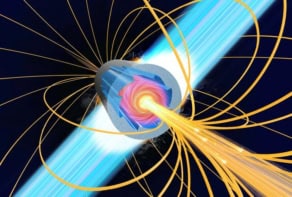Physicists in the US say they have witnessed the trademark coherence of a Bose-Einstein condensate in a cooled system of quasiparticles known as "polaritons". Although similar claims have been made before, other researchers in the field had suspected that the coherence was an effect of the laser beam used to create the polaritons, meaning the systems were not true condensates. This new experiment has removed doubt by accumulating polaritons away from the laser beam (Science 316 1007).
First created in 1995 from a gas of rubidium atoms, Bode-Einstein condensates (BECs) are systems in which a large number of bosons have collapsed into the same ground state. This enables the bosons to shed their random, classical behaviour and move as a coherent whole, providing a means to study quantum effects such as superfluidity in a macroscopic setting. The drawback is that the phase change normally takes place at temperatures close to absolute zero.
However, polaritons – which are bosons consisting of an electron-hole pair and a photon – are a billion orders of magnitude lighter than rubidium atoms, so should be able to form a BEC at much higher temperatures. The first claim of a polariton condensate came last year, when Jacek Kasprzak of the Université Joseph Fourier in Grenoble, France, together with colleagues in Switzerland and the UK, used a laser to steadily increase the density of polaritons in a semiconductor microcavity kept at the relatively warm temperature of 19 K. They found that above a critical density, the polaritons began to display the coherent behaviour of a BEC (see related story: “BECs confound at higher temperatures”).
Other researchers in the field doubted that the polaritons were a true BEC, though, because the behaviour was only seen in the region excited by the laser beam, which is itself coherent. To settle the matter, David Snoke and colleagues from the University of Pittsburgh and Bell Labs in the US have made a similar system in which the polaritons produced by the laser subsequently migrate away from the laser’s excitation. They did this by using a sharp pin, just 50 µm across, to create an inhomogeneous stress on the microcavity, which formed a trap that the polaritons could accumulate in. In this system, they found that a BEC still formed at a temperature of 4.2 K.
Although this is not as warm as the BEC at 19 K Kasprzak’s team reported, Snoke told Physics Web that since publication they have increased the condensation temperature to 32 K: “There is plenty of reason to expect we can go even higher…I would not predict room temperature, but over 100 K is not out of reach for us.” In addition, the US team’s microcavity is made from the widely-available semiconductor GaAs in a trapping system similar to that used in atomic gases, which will make the field easily accessible to more research groups.
Nonetheless, there may still be doubts whether Snoke’s system is a BEC in the conventional sense, because polaritons have such a short lifetime that the system can only reach a quasi-equilibrium. “Some people want to restrict the use of the BEC term to a system that is in true equilibrium,” said Snoke. “On the other hand, some people want to generalize it to include all sorts of systems including lasers. It’s more a question of terminology.”


